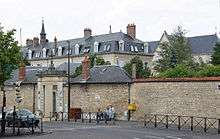Saint Gildard (Lurcy-le-Bourg)
| Saint Gildard | |
|---|---|
| Died | Lurcy-le-Bourg |
| Venerated in | Roman Catholic Church |
| Major shrine | St. Gildard Convent, Sisters of Charity of Nevers, Nevers |
| Feast |
24 August[1] |
Saint Gildard, or Saint Gildardus, is a saint of the Roman Catholic Church. He was a priest[3] in the seventh century of Lurcy-le-Bourg, in the Roman Catholic Diocese of Nevers.[1] His name remains in the convent of St. Gildard, operated by the Sisters of Charity of Nevers, and the final resting place of St. Bernadette of Lourdes.
History
The Bollandists have little to say on the saint—he was a priest in the seventh century who "edified with his virtues the parish of Lurcy-le-Bourg."[4] Local historians agree that little is known of this saint and repeat what was written in Les Petits Bollandistes.[2] The date of his death was 24 August, but because that day was already dedicated to Saint Bartholomew Gildard's feast day was moved to 31 August, and was celebrated on that day for three centuries, until in the Nevers area it was moved back to 24 August, according to Augustin-Joseph Crosnier, vicar-general of the Diocese of Nevers in the mid-nineteenth century. Crosnies also reports that an ancient ceremony directs that the celebration is to be accompanied with wine and warm bread rolls.[2]
Gildard's body was buried in a small church dedicated to a Saint Loup (known by the Latinised name of Saint Lupus), outside the city walls of Nevers. In the course of time, after miracles had occurred, the church came to be called after both saints, and later again the name of Lupus was forgotten.[2]
Church of St. Lupus and St. Gildard
Less is known of Lupus than of Gildard, though at least some historians believe that a Lupus had lived in the area and that some miracles were performed at the church that came to bear his name, which he later shared with Gildard. In the time of Charles the Bald and Charles the Fat, it was an abbey, and in the eleventh century became a parish church; by the end of that century it was left to the monastery of Saint-Laurent-l'Abbaye.[2]
The church suffered greatly during the Hundred Years' War, and the parish became so depopulated that the church was empty; in 1784 it was closed at the request of the local population. By the mid-nineteenth century, a wine press was in operation in two of the church bays, while the grounds were overgrown with vines.[2]
Saint Gildard Convent

In 1853, Dominique-Augustin Dufêtre, bishop of Nevers, assigned the church to be rebuilt as a religious house for the Sisters of Charity of Nevers. By that time, not much was left but a rectangular building; the remains of the thirteenth-century were used to build the Saint Gildard Convent, which was officially consecrated on 15 July 1856.[2] This is the motherhouse of the Sisters of Charity of Nevers, where in 1866 Bernadette of Lourdes entered to do her novitiate and where she died in 1879. Her body was buried on the convent grounds, in a special crypt, separate from the graves of the other sisters.[5]
References
- 1 2 Smith, William; Wace, Henry (1880). A Dictionary of Christian Biography, Literature, Sects and Doctrines, Being a Continuation of "The Dictionary of the Bible": Eaba-Hermocrates. J. Murray. p. 669. Retrieved 30 December 2010.
- 1 2 3 4 5 6 7 Crosnier, Augustin-Joseph (1858). Hagiologie nivernaise: ou, Vies des saints et autres pieux personnages qui ont édifié le diocese de Nevers par leurs vertus. I.-M. Fay. pp. 352–61.
- ↑ O'Hanlon, John (1923). Lives of the Irish Saints. James Duffy.
- ↑ Guerin, Paul (1878). Les petits bollandistes: vies des saints, d'après le père Giry, les grands bollandistes, Surius, Ribadeneira, Godescard, les propres de chaque diocèse et les travaux hagiographiques les plus récents, Vol. 7. Bloud et Barral. p. 349.
- ↑ Taylor, Thérèse (2003). Bernadette of Lourdes. Burns and Oates. p. 312. ISBN 0-86012-337-5.
